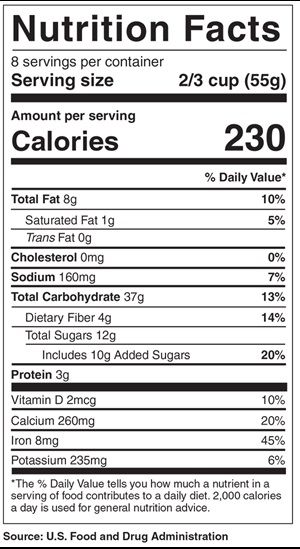
Reading nutrition labels
Reading nutrition labels
The main parts of a nutrition facts label 
- Serving size: The serving size lists how many calories and nutrients are in one serving of the food. If you eat twice the serving size, you are getting twice the amount of calories and nutrients.
- Calories: Calories are a measure of energy released by a food.
- Total fat: Total fat includes all types of fat (saturated, unsaturated, trans).
- Saturated fat: Saturated fat raises LDL (the “bad”) cholesterol. Reduce saturated fats to help protect your heart.
- Trans fat: Trans fats can raise LDL cholesterol, lower HDL cholesterol and add to heart disease. Eat as little trans fats as possible. Avoid foods that contain “partially hydrogenated” oils, including shortening.
- Cholesterol: Foods from animals (meat, fish, eggs, cheese, butter) have cholesterol.
- Sodium: Too much sodium (salt) can lead to high blood pressure. One teaspoon of salt has 2,400 milligrams of sodium. This is the upper limit most people need each day.
- Total carbohydrate: Carbohydrates give your body energy. However, too many can raise your blood glucose.
- Fiber: If the food has 5 grams or more of fiber, subtract half of the grams from the total carbohydrate.
- Total sugars: Sugar is included in the number of total carbohydrate.
- Added sugars: Studies have shown consuming more than 10 percent of your total daily calories from added sugar makes it less likely that you will meet your nutrient needs (while staying within your calorie goal).
- Protein: Protein is important for healing, building muscle, strengthening your immune system, helping your body recover from stress and more!
Related resources
Source: Allina Health Patient Education, Beginnings: Pregnancy, Birth and Beyond, eighth edition, ob-ah-90026
Reviewed By: Allina Health's Patient Education Department experts
First Published: 10/04/2002
Last Reviewed: 12/06/2021